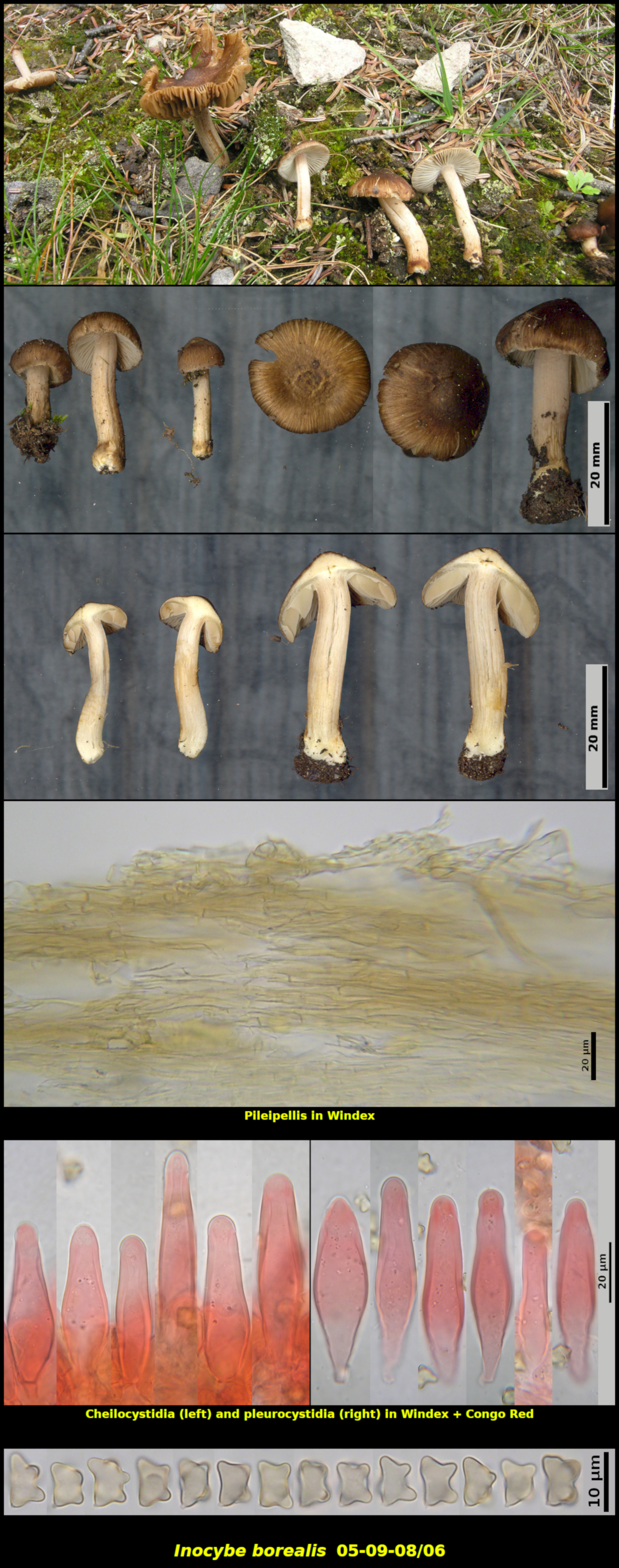Fleshy Fungi of New Brunswick >>
Inocybe borealis
Inocybe borealis M. Lange

Gregarious in disturbed exposed soil with mosses and sedges at edge of old woods road, growing in association with Abies balsamea, southwest of Chance Harbour, New Brunswick (05-09-08/06).
Pileus conic-turbinate at first, expanding to broadly convex to nearly plane at maturity, with a low broad umbo, moist, radially appressed-fibrillose, with fibrils never becoming lifted from the surface or recurved as scales, with fibers separating and becoming rimose toward the margin in older basidiomata, with some pale buff veil remnants at the margin when young, mostly Light brown (Methuen 6D4) to Dark brown (7F5-6) but with Yellowish brown (5D4-5) colours sometimes evident, 18-42 mm in diameter. Stipe equal down to a slightly bulbous base, Orange grey to Orange white (5BC2), with some brown staining around the bulb, pruinose at the apex, loosely fibrillose below the apex with material of the universal veil, 14-51 X 2.5-5.0 mm. Lamellae white at first, darkening to Brownish orange (5C3) as the spores mature and then finally Yellowish brown (5E5), close, adnexed, not marginate. Cortina pale buff, soon disappearing from the margin of the pileus but remaining as loose fibrils on the stipe. Flesh Yellowish white to Orange white (4-5A2) in the pileus, Orange white (6A2) in the stipe, with a marked spermatic odour.
Basidiospores orange brown in spore print, strongly nodulose with 7-8 well-defined obtusely conical nodules, 7.4-9.1(9.9) x 5.4-7.3 (8.4) μm, Q = 1.15-1.56 (average[37]: 8.1 x 6.1 μm, Q = 1.34). Pileipellis a thick cutis of narrow brown encrusted hyphae, loosening in the uppermost layers. Cheilocystidia abundant and forming a sterile margin, narrowly ventricose to lageniform, thick-walled, with walls up to 3.7 μm thick in the neck, without apical crystals in Windex and KOH but with these present in Melzer’s Solution, slightly yellow in KOH, 32-74 x 9.0-16.8 μm. Pleurocystidia abundant, scattered, similar in shape to the cheilocystidia, thick-walled, with walls up to 3.4 μm thick in the neck, with a prominent apical cap in Windex, 51-69 x 11.0-18.3 μm.
Fits Grund and Stuntz (Mycologia 75(2): 260. 1983) concept of I. heterochrominea rather well. Those authors stated that, “Its salient features are the red-brown, smooth to rimose pileus, incarnate stipe that is pruinose only at the apex, angular spores with few, moderate-sized nodules, and thick-walled pleurocystidia”. They record the “incarnate” stipe colour as Methuen 6A3, 6A4 and 6B4, which differs slightly from the description here of 5BC2, although this may only reflect different lighting conditions when the notes were written. The basidiospores in their drawings are quite similar to those in Collection 05-09-08/06.
Inocybe borealis is described as having basidiospores 10.7-11.7 x 5.9-6.9 μm, considerably longer than those described for Collection 05-09-08/06. In addition, Lange illustrated the basidiospores of I. borealis as alost smooth to angular, and quite unlike the strongly nodulose ones of our collection.
Recent sequences of both types are now available suggesting I. borealis and I. heterochrominea to be conspecific. Kokkonen and Vaurus (Mycol. Progress 11: 299-341. 2012) discussed these species in detail and accepted their synonymy under the older name I. borealis. They stated that the basidiospores of the type of I. borealis are rather elongated compared to those of other collections.
Photo: D. Malloch (05-09-08/06).